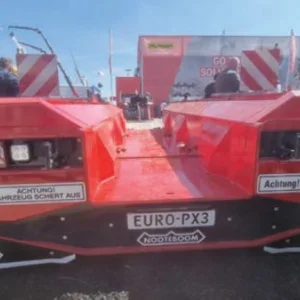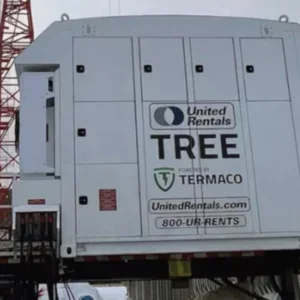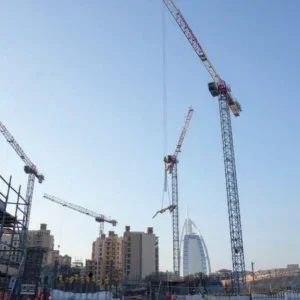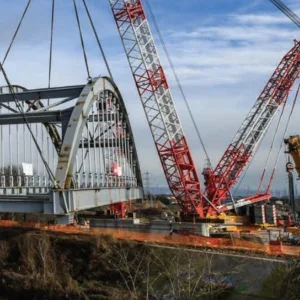All three companies were formed out of a handful of regional firms less than ten years ago, of which there are many: plant-hire firm GAM estimates there are 2,000 small Spanish equipment rental, its rival Euroloc reckons 1,500.
GAM and Euroloc both argue that the market is fragmented, with few large players, and have stated a desire to consolidate the industry. On paper, Eurogrúas is the same: it started about 10 years ago from a group of six companies, and says that it wants to consolidate its patch. But there are several major differences.
The competitors
First, GAM and Euroloc are the only equipment rental companies to cover all of Spain, while Eurogrúas stays in the south. Although both include cranes within their range, their business extends to general construction equipment such as aerial work platforms and generators. Both are much larger than Eurogrúas, and have received outside funding to support their growth.
The biggest is GAM, General de Alquiler de Maquinaria, roughly translated as General Machinery Rental, which was established in 2003 from the consolidation of five equipment rental firms. It has 43,000 machines, 1,500 employees in 68 branches and expects a 2007 turnover of EUR250m, if planned acquisitions proceed. Its sales revenues were EUR186m in 2006. GAM CEO Pedro Luis Fernández says that the company’s aim is to “concentrate the industry”. From 2003 to 2006, the company was 80% owned by risk capital funds Dinamia and Nmás1 Private Equity Fund, which financed its growth. Asturias-based bank Cajastur (Caja de Ahorros de Asturias) and GAM management each owned 10%. In 2006, the company went public, and Dinamia and Nmás1 sold their shares to other investors. GAM’s latest acquisition, in June, was of aerial work platform rental company Vilatel.
In August 2005, GAM announced plans to reduce its exposure to the construction industry from 80% to 60% and to diversify its business beyond machinery rental. At that point, 80% of GAM’s earnings were from equipment rental in the construction industry. The company decided to reduce that to 60% by 2010, through diversification. “The big companies at European level have succeeded in getting 20% of their sales from the assembly of large events,” said Pedro Luis Fernández, at the time. Since then it has set up separate specialist divisions for equipment rental in events, energy, railway, ports, industrial maintenance, and parks.
In June, Euroloc predicted its sales revenues would reach a total of EUR160m in all of Spain, which would make it number two, after GAM, in the Spanish market. (It made EUR76m in 2006). Formed in 2004 from nine regional companies, Euroloc boasts 29,000 items of equipment from 51 depots. It says that its strategy is to increase market share and geographical coverage by opening new depots and acquiring complementary businesses.
Euroloc’s latest acquisition was Catalan crane rental company Grúas Homs, in June 2007 for an undisclosed sum. “It is a totally complementary business”, explains Juan Dionis, chairman of Euroloc Group. “Grúas Homs allow us to extend our cover in Catalonia, a very important geographic zone for our growth. In addition, thanks to its highly qualified equipment and its capacity for management demonstrated in the maintenance of machines, we will take advantage of synergies to impel the attainment of our global objectives of yield and quality”.
The acquisition triples Euroloc’s depots in the region of Catalonia, to 10, and adds 110 employees to its books. Former Grúas Homs managing director, Vicente Homs, now becomes Euroloc’s Catalonia region director.
The company called the acquisition a new step in the company’s plan of organic and strategic growth. “We want to turn Euroloc Group into the primary supplier of the machinery rental sector of our country”, Juan Dionis says. “The Spanish supply of machinery rental is very fragmented, and only two companies, GAM and Euroloc Group, are a considerable size compared to 1,500 small competitors: this creates a positive environment for consolidation.”
Outside investment, again, has brought in much of the money required for this consolidation. Advent International became Euroloc’s principal shareholder in 2006 when it bought 80% of the company for an undisclosed sum (previous acquisitions include French machine leasing company Loxam, which it bought into in 1999, and exited in 2003, selling its share to the management team and a new private equity investor, HarbourVest Partners). The remainder is currently owned by mezzanine fund the Intermediate Capital Group and the company directors.
The cooperative
Eurogrúas does not share GAMand Euroloc’s private finance backing, or their national ambitions. Although it has a large crane fleet by some measures (listing 1,060 mobiles, 10 crawlers and 375 tower cranes, in the last Cranes Today Fleet File), it does not follow the same acquisition based growth strategy.
Its main ambition is to be a regional, rather than a national player, says Eurogrúas chairman Javier Sato, and its patch is southern Spain.
“The south of Spain, from Madrid to the south, is like a single big country,” says Sato, who is also the managing director of subsidiary Invergrúas. “We have a strong network of commercial links because every part of the south of Spain is covered by one firm. Each firm knows their territory. We use the knowledge of every firm and add their knowledge to our knowledge.”
Each depot is run by one partner, who works “very independently” in managing the business day to day. Bigger questions (investment, growth, expansion) are decided by the board of directors, which meets weekly. Each director directs one of the founding companies, and they share ownership in Eurogrúas 2000, which is managed by Antonio Caparrós. The founding companies are: Grúas Alhambra from Granada, Grúas Bahía from Cadíz, Grúas y Transportes Gil from Seville, Grúas Raimundo from Málaga, Grúas Valeriano from Murcia and Invergrúas from Algeciras.
The companies started to cooperate in 1997, but only this year, their tenth anniversary, does the group really work as a single company, according to Sato. The company is currently working to roll out a standard logo, standard uniforms, and a standard computer system.
The company has two current strategic initiatives. “Now we want to consolidate what we have in the south of Spain, from Madrid to Gibraltar. We will consolidate to see work in Portugal. In fact we will work wherever there’s work,” Sato says.
He claims it is the only big company with tower cranes as well as mobiles. It currently has 400, through its business Eurogrúas Grúas Torre. “We began this in 2003, because there was a boom in Madrid, and in Spain as well. Usually the same people hire tower cranes as mobile cranes. We already had a good commercial network, so we are using the same network to have clients from tower cranes.”
Eurogrúas is also launching a heavy lift service, and will take delivery of a 1,350t-capacity Liebherr LR 11350 crawler crane in October, which it will add to three 600t capacity Demag CC 2800s. Eurogrúas member companies tend to share cranes above 200t capacity, Sato says. “Today it is in Cadíz, tomorrow Granada. The same is true for the 500- and 600-tonners.”
The six companies have collaborated on other initiatives, including rental companies in new areas, such as the Spanish province of Extremadura adjacent to Portugal (Eurogrúas Extremadura), in 1999, or Morocco (Eurogrues Maroc), 2007, and renting other equipment, such as aerial work platforms (Europlataformas 2000).
Sato is positive about the Spanish construction market: “We recognise that there is a lot of competition, a lot of firms with lots of cranes, but there is still a lot of work to do, so this is no problem. In the future the market will decrease, and this will be a problem for a lot of firms, but for now, it’s no problem,” Sato says.
“The construction market in Spain is not increasing as much as a few years ago, but it is still increasing. Although house and office construction is not increasing, other civil engineering works, such as bridges, are still growing, and other sectors, such as oil and gas and energy, are also growing.”
Euroloc service vans Euroloc service vans A Eurogruas telescopic crane lifts a column in a petrochemical refinery Eurogruas refinery lift A Eurogruas tractor and trailer move a large fabrication Eurogruas haul






